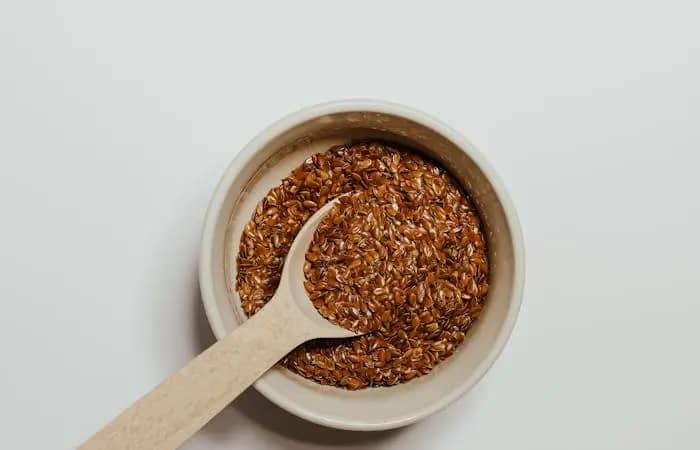Flax seeds is one of the most beneficial seed, which is full of nutrients that can improve your well-being. Flax seeds are rich in omega-3 fatty acids, fiber, and essential nutrients.
Adding flax seeds into your diet can be a game-changer. However, to check their full potential, it is important to know how to grind flax seeds correctly. So, In this article , we will take you through some of best methods on how to grind flax seeds. (1)
Table of Contents
ToggleWhy Grind Flax Seeds?
Flax seeds have a tough/solid outer shell that basically holds their nutritional powerhouse. So, by Grinding these seeds helps break down the tough exterior, making the nutrients more accessible for absorption.
Additionally, the ground form improves the versatility of flax seeds. Which allows you to use them into variety of dishes.
Methods to grind flax seeds

-
- Coffee Grinder:
-
- Using a coffee grinder is one of the most efficient tool/methods. Simply add the desired amount of flax seeds into coffee grinder and pulse until you achieve a fine powder.
-
- Make sure that your coffee grinder is clean to avoid any unwanted flavors.
-
- Coffee Grinder:
-
- Blender or Food Processor:
-
- If you don’t have a coffee grinder (don’t worry) , a blender or food processor can also do the job for you. Batch process small amounts at a time to ensure an even grind.
-
- Be cautious not to over-blend, as the heat generated may compromise the nutritional integrity of the seeds.
-
- Blender or Food Processor:
-
- Manual Methods:
-
- Mortar and pestle or a spice grinder can be used for a manual approach. While this method might take a bit more effort, it allows for better control over the grind consistency.
-
- Manual Methods:
-
- Pre-Ground Flax Seeds:
-
- Alternatively, pre-ground flax seeds are available in many grocery stores. However, keep in mind that the nutritional potency might diminish over time due to oxidation.
-
- Pre-Ground Flax Seeds:
Tips for Grinding Flax Seeds:
-
- Use Fresh Seeds:
-
- Always use fresh, whole flax seeds to ensure maximum nutritional benefits. The oils in flax seeds can become rancid over time, affecting both taste and nutritional content.
-
- Use Fresh Seeds:
-
- Store Properly:
-
- Store flax seeds in a cool, dark place to prevent them from going rancid. Consider keeping them in an airtight container in the refrigerator for extended freshness.
-
- Store Properly:
-
- Grind Flax Seeds in Small Batches:
-
- Grinding small batches at a time ensures an even consistency and prevents the seeds from overheating, which could affect their nutritional value.
-
- Grind Flax Seeds in Small Batches:
-
- Incorporate Immediately:
-
- To preserve the nutritional integrity, use the ground flax seeds immediately or store them in an airtight container in the refrigerator.
-
- Incorporate Immediately:
Incorporating Ground Flax Seeds into Your Diet
Here’s a step-by-step guide to help you seamlessly integrate ground flax seeds into your daily meals:
Step 1: Purchase Fresh Ground Flax Seeds
-
- Start by acquiring fresh ground flax seeds. You can either purchase them pre-ground from a reputable source or grind whole flax seeds at home using a coffee grinder, blender, or food processor.
Step 2: Determine Your Daily Serving Size
-
- Understand the recommended daily intake of flax seeds, which is typically around 1 to 2 tablespoons. Adjust the quantity based on your dietary preferences, but be mindful of moderation to avoid excessive fiber intake.
Step 3: Add to Breakfast Cereals or Oatmeal
-
- One of the easiest ways to incorporate ground flax seeds is by sprinkling them over your morning cereal or oatmeal. The mild, nutty flavor seamlessly blends with these breakfast staples.
Step 4: Mix into Yogurt or Smoothies
-
- Enhance the nutritional content of your yogurt or smoothies by mixing in ground flax seeds. This not only adds a nutritional boost but also provides a subtle crunch.
Step 5: Blend into Soups and Stews
-
- For a savory twist, stir ground flax seeds into soups, stews, or chili. The neutral taste won’t overpower the dish, and you’ll benefit from the added fiber and omega-3 fatty acids.
Step 6: Incorporate into Baked Goods
-
- Upgrade your baking recipes by substituting a portion of flour with ground flax seeds. This works particularly well in muffins, pancakes, and bread, contributing both nutritional value and a pleasant texture.
Step 7: Mix with Salad Dressings
-
- Create a nutrient-packed salad dressing by whisking ground flax seeds into vinaigrettes. Drizzle this mixture over your favorite salads to enjoy the health benefits along with added flavor.
Step 8: Sprinkle on Nut Butters or Toast
-
- Elevate your morning toast or nut butter spread by sprinkling a layer of ground flax seeds. The combination of textures and flavors creates a satisfying and nutritious meal.
Step 9: Incorporate in Energy Bites or Bars
-
- For a convenient and portable snack, mix ground flax seeds into homemade energy bites or granola bars. This not only adds nutritional value but also contributes to the binding texture of the snacks.
Step 10: Experiment with Savory Dishes
-
- Get creative in the kitchen by experimenting with ground flax seeds in various savory dishes. Consider incorporating them into sauces, meatballs, or even as a coating for fish or chicken.
You can also incorporate flax seeds in your diet for weight loss.
In a nutshell
Grinding flax seeds opens the door to a world of nutritional possibilities. By following the methods and tips outlined in this guide, you can effortlessly incorporate these tiny powerhouses into your daily diet, reaping the benefits of enhanced heart health, improved digestion, and a wealth of essential nutrients. So, grab those flax seeds and start grinding your way to a healthier you!
FAQ’s on flax seeds
Q1: Can I Eat Flax Seeds Whole, or Should I Grind Flax Seeds?
A1: While whole flax seeds offer nutritional benefits, their tough outer shell may limit nutrient absorption. Grind flax seeds before consumption allows for better absorption of nutrients, especially omega-3 fatty acids.
Q2: Is it Safe to Consume Flax Seeds Daily?
A2: Yes, it is generally safe to consume flax seeds daily. However, moderation is key. Excessive intake may lead to digestive issues due to the high fiber content. It’s advisable to start with a small amount and gradually increase.
Q3: Are Flax Seeds Suitable for Everyone?
A3: Flax seeds are generally safe for most people, but those with certain conditions, such as digestive disorders or allergies, should consult a healthcare professional before adding them to their diet. Pregnant or breastfeeding women should also seek advice.
Q4: Can I Store Flax Seeds, and for How Long?
A4: To maintain freshness, store flax seeds in an airtight container in a cool, dark place or the refrigerator. Whole seeds can last up to a year, while ground flax seeds are best consumed within a few weeks for optimal nutritional value.
Q5: Are there Different Types of Flax Seeds?
A5: There are two main types of flax seeds: brown and golden. Nutritionally, they are similar, but some may prefer golden flax seeds for their milder flavor. When it comes to health benefits, both types offer comparable advantages.




